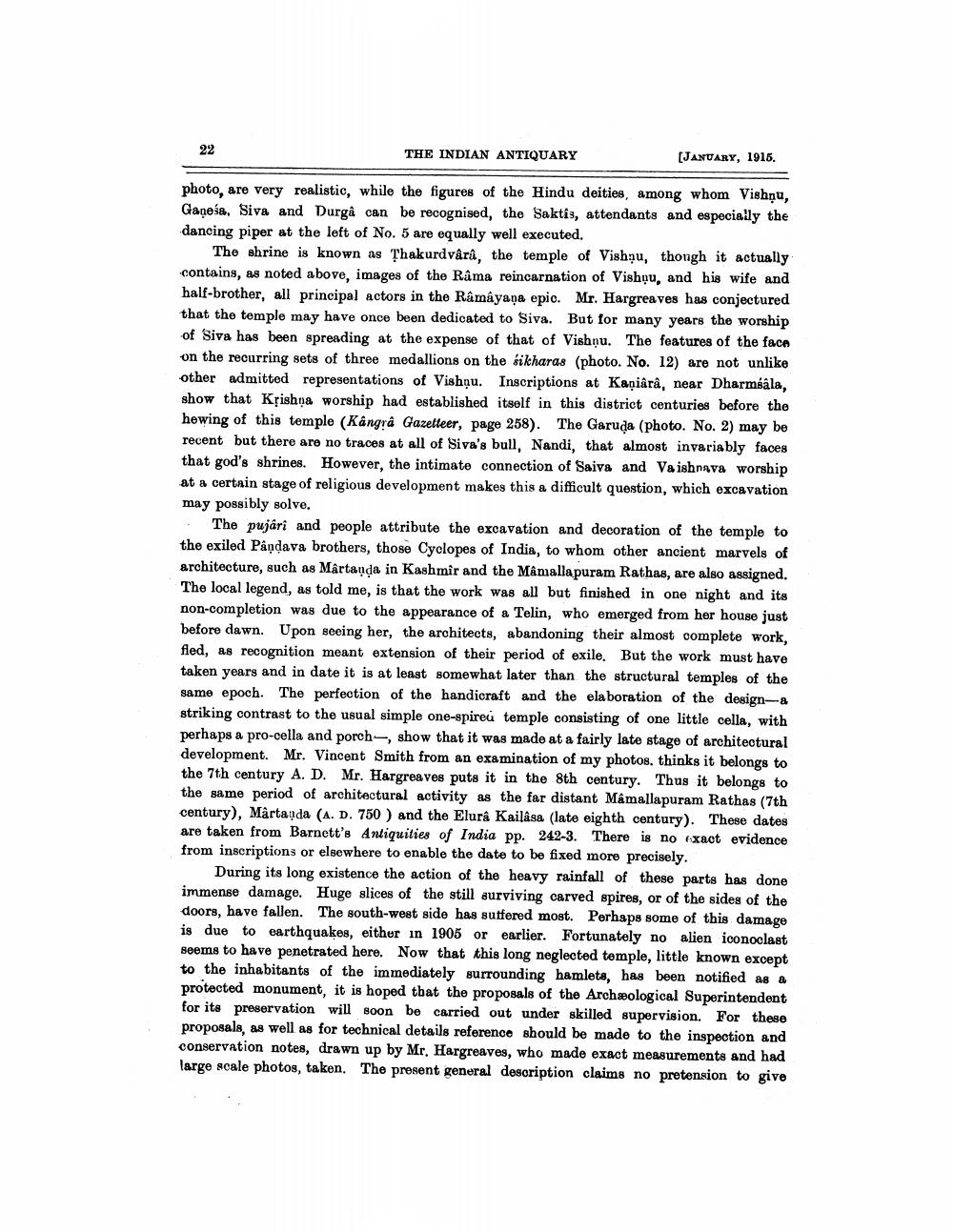________________
22
THE INDIAN ANTIQUARY
(JANUARY, 1915.
photo, are very realistic, while the figures of the Hindu deities, among whom Vishņu, Gaņeśa, Siva and Durga can be recognised, the Saktis, attendants and especially the dancing piper at the left of No. 5 are equally well executed.
The shrine is known as Thakurdvârâ, the temple of Vishņu, though it actually contains, as noted above, images of the Rama reincarnation of Vishyu, and his wife and half-brother, all principal actors in the Ramayana epic. Mr. Hargreaves has conjectured that the temple may have once been dedicated to Siva. But for many years the worship of Siva has been spreading at the expense of that of Vishnu. The features of the face on the recurring sets of three medallions on the bikharas (photo. No. 12) are not unlike other admitted representations of Vishņu. Inscriptions at Kaņiârâ, near Dharmsála, show that Kțishra worship had established itself in this district centuries before the hewing of this temple (Kängrå Gazetteer, page 258). The Garuda (photo. No. 2) may be recent but there are no traces at all of Siva's bull, Nandi, that almost invariably faces that god's shrines. However, the intimate connection of Saiva and Vaishnava worship at a certain stage of religious development makes this a difficult question, which excavation may possibly solve.
• The pujari and people attribute the excavation and decoration of the temple to the exiled Pandava brothers, those Cyclopes of India, to whom other ancient marvels of architecture, such as Mârtanda in Kashmir and the Mamallapuram Rathas, are also assigned. The local legend, as told me, is that the work was all but finished in one night and its non-completion was due to the appearance of a Telin, who emerged from her house just before dawn. Upon seeing her, the architects, abandoning their almost complete work, fled, as recognition meant extension of their period of exile. But the work must have taken years and in date it is at least somewhat later than the structural temples of the same epoch. The perfection of the handicraft and the elaboration of the designstriking contrast to the usual simple one-spireu temple consisting of one little cella, with perhaps a pro-cella and porch show that it was made at a fairly late stage of architectural development. Mr. Vincent Smith from an examination of my photos, thinks it belongs to the 7th century A. D. Mr. Hargreaves puts it in the 8th century. Thus it belongs to the same period of architectural activity as the far distant Mamallapuram Rathas (7th century), Martanda (A. D. 750 ) and the Elurá Kailasa (late eighth century). These dates are taken from Barnett's Antiquities of India pp. 242-3. There is no exact evidence from inscriptions or elsewhere to enable the date to be fixed more precisely.
During its long existence the action of the heavy rainfall of these parts has done immense damage. Huge slices of the still surviving carved spires, or of the sides of the doors, have fallen. The south-west side has suffered most. Perhaps some of this damage is due to earthquakes, either in 1905 or earlier. Fortunately no alien iconoclast seems to have penetrated here. Now that this long neglected temple, little known except to the inhabitants of the immediately surrounding hamlets, has been notified as a protected monument, it is hoped that the proposals of the Archæological Superintendent for its preservation will soon be carried out under skilled supervision. For these proposals, as well as for technical details reference should be made to the inspection and conservation notes, drawn up by Mr. Hargreaves, who made exact measurements and had large scale photos, taken. The present general description claims no pretension to give




